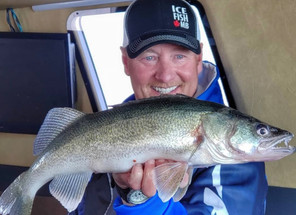Posted by Chris Larsen on 8th Dec 2020
Ice Fishing Walleyes With Underwater Cameras
Kurt Walbeck spends most of his winters traveling throughout the ice belt trying to catch big fish through the ice. Walbeck is the host of the regional television show, Outdoor Bound TV. His travels often take him north of the border, but that will change in 2020-21 due to restrictions on border crossings during the COVID pandemic. A recent Outdoor Bound TV episode features Walbeck using a MarCum underwater camera while targeting walleyes. “We were fishing on a lake called Reed Lake which is probably one of the more popular lakes in that northern region of Manitoba. It’s popular because it has great lake trout, great walleyes, and huge pike. Really a lot of trophy fish and it’s a pretty clear body of water so it’s a great body of water for underwater cameras.”
Underwater cameras are becoming more and more popular as ice anglers see the advantage of being able to see what’s happening below the surface of the ice. “We started using the Quest HD last season and we used it primarily in our Yetti wheelhouse. It’s a great camera. We love the HD function. In fact, in a lot of lakes that we’re using the wheelhouse, we can drop the camera in the front of the wheelhouse looking backward and see everyone’s bait that is fishing in the wheelhouse depending on what body of water and how clear it is. Then we started taking it out in a little more of a mobile situation. It’s an easy camera to take along… A great camera on it. The key is it has a great sun visor that goes over the screen so it’s easy to see whether you’re out and about on the ice or in the case we were, in our Otter shack.”

Underwater cameras are incredibly popular among panfish anglers but many walleye enthusiasts believe cameras spook fish. Walbeck says that hasn’t been his experience. “I was a believer of that same thing… the fewer things down there for walleyes the better. But we started using the camera a lot in a lot of different functions. What we found was that the fish were not leery of the camera. I was a believer that was the case so we didn’t use it in a lot of cases, especially in clear water. What we found was exactly the opposite of that. The fish we’re really curious of it. For as many fish as we saw come up to the bait, just as many would come up to the camera and they would bump the camera a little bit. They were actually pretty curious about it.”
Walbeck is using distance as a tool to avoid spooking fish. “One of the things we’ve done in the past, especially for walleyes, is we would take a plastic vine and wrap it around the cord going up to conceal it. Frankly, we used it a few times and after that we scrapped it. We didn’t need to. Very seldom did we see fish in the distance and have them not approach the bait because the camera is right behind them. One of the things we do is, depending on the clarity of the water, we back the camera off as far as we can and still be able to see our bait. You’ll have to judge that based on the clarity of the water and how much light is coming down under the ice.”
While he still uses sonar in conjunction with the underwater camera, cameras do have some advantages over sonar. “There’s a couple of things. First, when you’re using your sonar you don’t know what species of fish you’re dealing with, especially on a body of water like Reed Lake. You’ve got lake trout, burbot, whitefish, pike, and all different species of fish. You really don’t know what you’re dealing with using sonar in many situations. One of the things it immediately did was to tell us if we’re wasting time trying to get burbot to bite or if we’re chasing whitefish. Instantly it tells you what species you’re dealing with. The other thing is, I was shocked when I first started using MarCum underwater cameras, how many fish would react negatively to your bait as you were moving the bait. Sometimes fish want an extremely slow presentation. Some want a dead presentation. Others want an extreme up and down. What we found is we were able to fine-tune the presentation to what the fish wanted.”
Sonar is definitely more effective in low light situations and in turbid water. When conditions are right, Walbeck believes that using both sonar and a camera is a deadly combination. “Unless you’re constantly panning the camera, it’s tough to get multi-directional. What I typically do is have my MarCum LX or MX-Series down. I have the cone at 20-degrees to get the widest look that I can get in the water column so I can see 360-degrees around the hole. Again, I’ll set the camera back facing my bait so that as fish approach the bait I can see how they’re reacting to it.”
Kurt Walbeck is a recent guest on the Fish House Nation Podcast. To listen to the full conversation, click the player below or click here to go to our podcast page.

